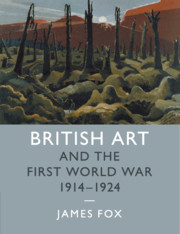Book contents
- Frontmatter
- Contents
- List of plates
- List of figures
- Acknowledgements
- Introduction
- 1 The outbreak of war and the business of art
- 2 Perceptions of art
- 3 The arts mobilize
- 4 War pictures: truth, fiction, function
- 5 Peace pictures: escapism, consolation, catharsis
- 6 Art and society after the war
- Conclusion
- Notes
- Bibliography
- Index
- Index
6 - Art and society after the war
Published online by Cambridge University Press: 05 August 2015
- Frontmatter
- Contents
- List of plates
- List of figures
- Acknowledgements
- Introduction
- 1 The outbreak of war and the business of art
- 2 Perceptions of art
- 3 The arts mobilize
- 4 War pictures: truth, fiction, function
- 5 Peace pictures: escapism, consolation, catharsis
- 6 Art and society after the war
- Conclusion
- Notes
- Bibliography
- Index
- Index
Summary
At 11 a.m. on 11 November 1918 the Armistice between the Allies and Germany came into effect, and 1,560 days of conflict finally stuttered to a close. Much as in August 1914, many people felt that an entirely new world had been inaugurated. One of them was the Prime Minister. On the day after the Armistice, from his office in Downing Street, David Lloyd George declared that Britain stood on the threshold of a new era. The war had exposed the country's failings, tested its character and dismantled many of its traditions. Victory, therefore, was an invaluable ‘impetus to reform’ – a golden opportunity to rebuild the country better than it had been before. Lloyd George then outlined a vast housing programme, a raft of educational initiatives, reduced labour hours, a new minimum wage and a promise to bring ‘light and beauty into the lives of the people’. All of this, he maintained, would be underpinned by the spirit of national unity, cooperation and self-sacrifice that had characterized British life during the war: ‘If’, he concluded, ‘that spirit can be preserved for five years, the face of this country will be transformed.’
If this was a pivotal moment for British society, it was also a pivotal moment for British art. The conflict, after all, had affected the latter as fundamentally as the former. War conditions may have initially marginalized art, but they had also created opportunities. The more ingenious members of the art world had established a new and more central place for themselves in national life, and the government as well as the public had embraced them accordingly. But now that the war was over conditions looked set to change again, and the art world was faced with a slew of pressing questions: what would happen to British artists’ new, and hard-won, social position? Would art institutions take up as constructive a role in the Peace as they had done in the War? What kind of painting and sculpture would dominate the years ahead? And, perhaps most pressingly, would an exhausted and traumatized nation have any time for art at all?
This chapter seeks to answer those questions by examining the years 1919 to 1924 – the five-year period that Lloyd George believed was so crucial to Britain's post-war recovery.
- Type
- Chapter
- Information
- British Art and the First World War, 1914–1924 , pp. 133 - 156Publisher: Cambridge University PressPrint publication year: 2015



